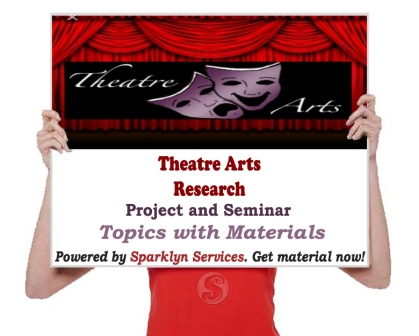1.0 Introduction
1.1 Background of the Study
Theatre is a collaborative form of art that uses live performance of a real or imagined event before a live audience in a specific place. The performer may communicate this experience to the audience through combinations of gesture, speech, song, music, or dance. Elements of design and stage craft are used to enhance the physicality, presence, and immediacy of the experience.
The specific place of the performance is also known by the world “theatre” as derived from ancient Greece (theatron: a place for viewing) and (theaomar: “to see” “to watch” “to observe”). This is born out by the Web Unabridged Dictionary which says that the word theatre means “an outdoor structure for dramatic performance of spectacle in ancient Greece and Rome”
However, theatre as a creative art, as described by scholars, makes use of the mind, body and human voice as means to an end, that is the entertainment of its audience. There are many branches that make-up theatre, these include but not limited to play directing, acting, and stage management playwriting, technical directing which includes set design, lighting sound, costume design, and make-up.
Lighting in theatre means illumination that is the deliberate use of light to achieve a practical or aesthetic effect in a performance. Lightening includes the use of both artificial light source (lanterns) as well as natural illumination by capturing daylight.
Lighting is the illumination of the performance on stage. Light is a flexible atmospheric visual element in theatre which helps to determine mood, time and also provide focus on stage. Lighting as an art is very crucial for the successful prosecution of a production, no matter the level of sophistication of the performance in question.
1.2 Objectives of the Study
This research is on the development of lighting in the renaissance and modern Eras. The major aim of this research is to properly elucidate and analyse lighting design and application in theatrical productions in the renaissance and modern eras.
It also looks at the lighting equipment used and how these lighting equipment have changed in design and usage through the ages. This research would also dwell on a comparative and contrastive study of lighting in both eras.
1.3 Rationale for the Study
People go to theatre to watch a performance without knowing anything about the use of lighting in theatre. Emphasis is mostly placed on the actors. For this reason, the usefulness and impact of lighting in the production is usually not known, acknowledged, or appreciated.
It is on this premise that this research not only intends to create awareness on the quality and the impact of lighting in theatrical productions down the ages, but also on the development of lighting equipment from a historical perspective.
The research will also dovetail to look at how the Delta State University theatre has fared with regards to lighting. This thesis will thus open a new vista into this production element known as light and its application. This would, in turn, help to make its place in the production process to be easily understood by the audience especially.
1.4 Significance of the Study
The findings of this research will benefit the society by serving as a historical material. It would make lighting and its place in a production more easily understood.
It would also benefit researchers and students in situating lighting properly as part of a production.
1.5 Research Methodology
Research methodology is a collective term for the structured process of conducting research, there are different methodologies used in various types of research. In this work, the methodologies that would be used are the historical and literary methodologies.
This research shall make use of the historical methodology to trace the beginnings and development of lighting in the renaissance and modern Eras.
The literary methodology focuses on written and printed library and archival sources, especially books, journals, theses, amongst others. These sources shall supply the bulk of the material to be used in prosecuting this research.




